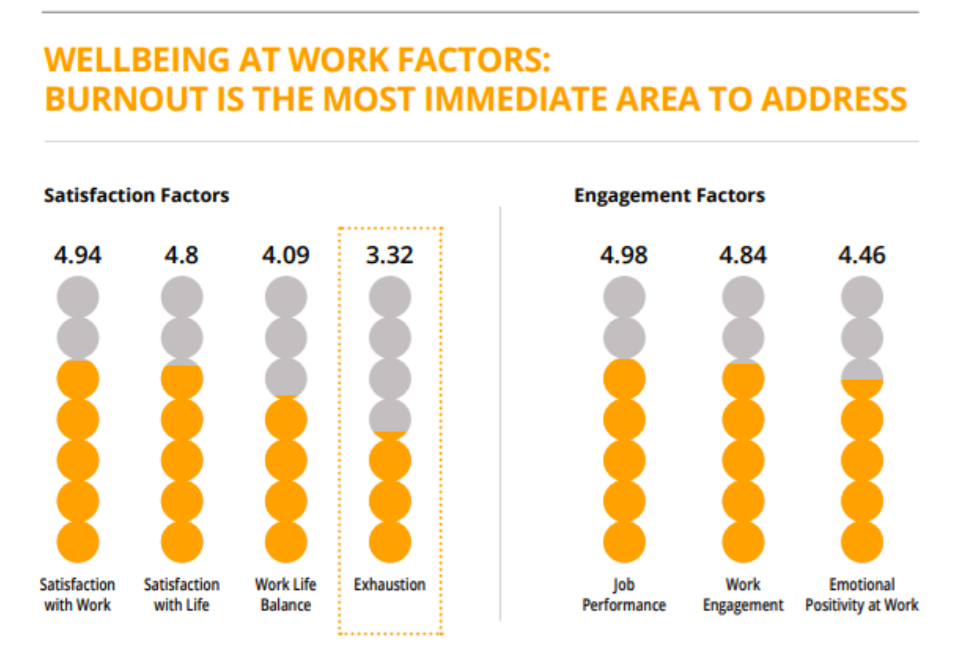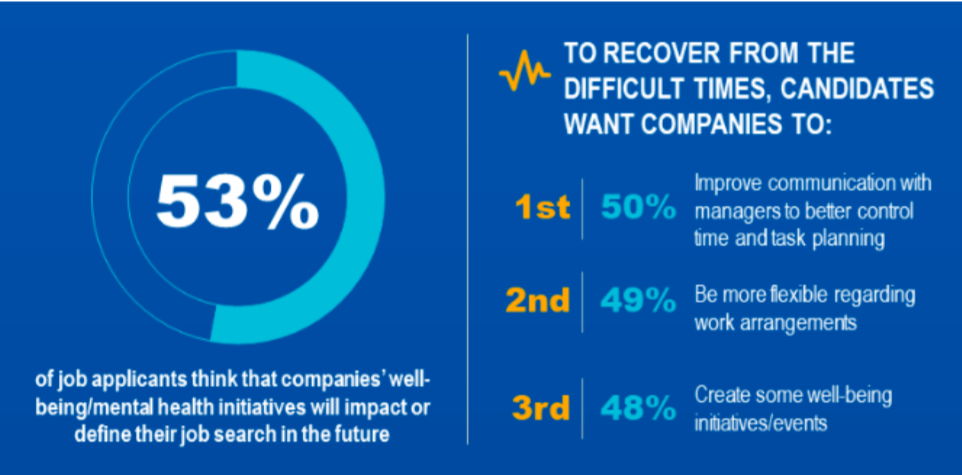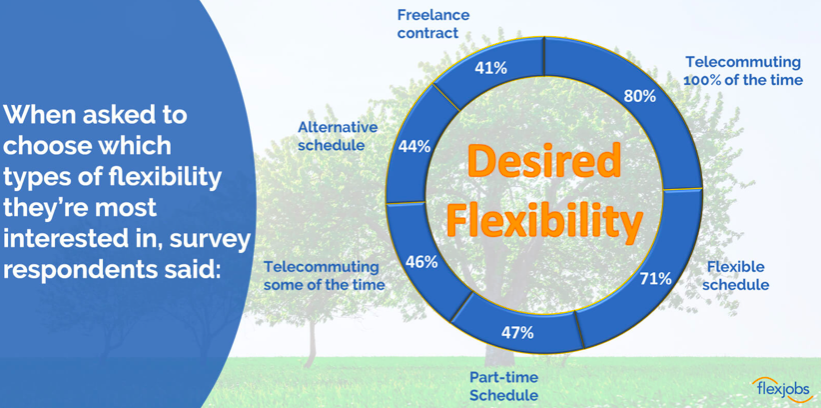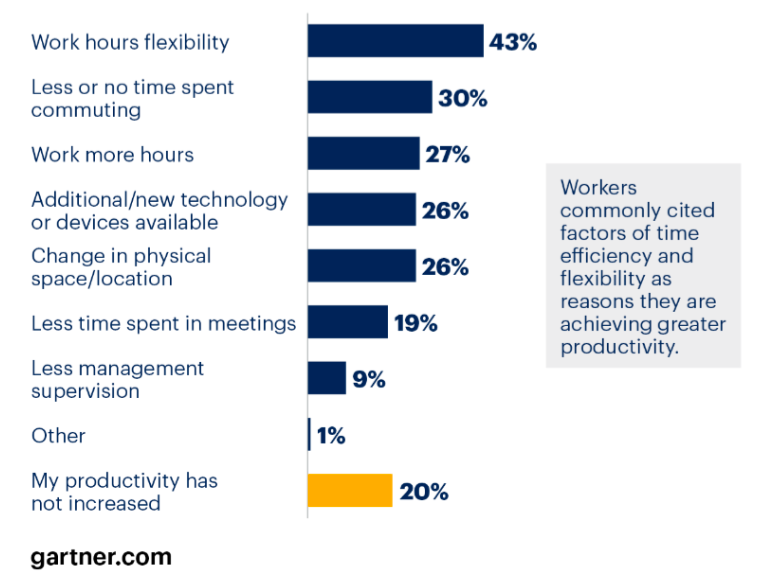The lockdowns that followed on the heels of the COVID-19 pandemic opened the eyes of many managers and executives to the need to learn how to manage mental health in the workplace.
A March 2020 study by Mind Share Partners, a non-profit organisation dedicated to studying mental well-being, showed that 42% of global employees facing the pandemic reported a decline in employee mental health.
Of course, mental health issues in the workplace did not originate with COVID-19.
A 2019 study by Business for WellBeing Council, a public-private partnership devoted to well-being in UAE’s private sector, found that 34% of respondents were anxious, 21% were depressed, 27% drained, and 44% tired.
Anxiety and Depression in UAE’s Private Sector

Source: Wellbeing in the Private Sector Report
Workplace burnout and absence of work-life balance were the two key culprits for employees reporting poor mental health. Also, the study found that 50% of those who were depressed and 45% of those who were anxious were looking to change jobs.
Burnout and Absence of Work-life Balance as Key Factors for Mental Health Decline

Source: Wellbeing in the Private Sector Report
The UAE government has responded to these issues with the new Labour Law (Federal Decree-Law No.33 of 2021), designed in part to better support mental health and wellness.
For example, 12 types of work permits and 6 different work models were introduced, a Monday-Friday work schedule was introduced, laws against sexual harrasment and discrimination were made, and leave on the grounds of compassion was permitted, among others, reported MEED, a Middle East business intelligence company.
Nevertheless, MEED still reported that 36% of respondents in a study expressed high stress from work, a precondition for poor employee mental health.
Business enterprises must also implement their own policies and strategies designed to support mental health and improve the mental wellness of employees.
This will become even more important in the future as 53% of employees believe that companies’ mental health initiatives will impact their job search, according to data from PageGroup, an employment agency.
In other words, both altruism and self-interest demand that companies pay close attention to mental well-being.
In this article, we will consider how to manage mental health in the workplace by highlighting eight ways that HR managers and executives can support and improve employee mental health at work.
[Do you want to reduce your employees’ anxiety by introducing financial inclusion services to support both employer payroll and employee well-being with benefits such as money transfer and bill payment services? Learn more about NOW Money’s digital platform, or sign up at NOW Money to start integrating a simple, flexible, and effective payroll management system.]
1. Improved and more open communication
Hiring managers that know how to communicate with employees properly can go a long way.
Fifty percent of the respondents in the survey by PageGroup mentioned above believe that improved communication with their managers to better control time and task planning is the most important step a company can take to support and improve mental health and employee well-being.
Communication and mental health

Source: Post-COVID, Mental Health Matters for UAE’s Workforce
Furthermore, the study by Mind Share Partners also shows that employees who believe their managers are bad at communicating are 23% more likely than others to experience mental health declines.
Therefore, as a manager or executive, you can work to support and improve the mental well-being of your workers by providing open and transparent communication.
This includes planning their time and tasks such that they are not overburdened at any particular period. Similarly, managers must learn to better communicate changes in work schedules, deadlines, deliverables, or organisational policies in a way that doesn’t make workers anxious or burdened. As noted above, workplace burnout is one of the core reasons for employees’ mental health decline.
“When information is withheld and communication is minimal, employee stress can rise simply because of the unknown,” said Michigan State University. “Managers should make it a practice to provide open communication, ensuring employees receive timely, transparent updates, understand expectations and understand how their performance is benchmarking against goals.”
2. Show authenticity when talking about mental health
Removing the stigma associated with mental health at work can foster a community of openness and mutual empathy.
A study published in the Science Direct journal has shown a positive correlation between authentic leadership, positive work culture, and employee mental health at work. This is because a large number of those who struggle with varying levels of mental health issues don’t want to talk about it or seek help because they are afraid of the stigma.
Therefore, managers and executives who want to help workers can lead the way by being authentic about mental health struggles they have encountered if any.
We live in an age of authenticity where people are more comfortable talking to people who they believe can sympathise and empathise with them. Consequently, as long as workers believe their managers and executives are somehow above the plane, living in their secluded world of tranquillity and utmost mental health and well-being, they will be less open to sharing their own mental health troubles.
On the other hand, if managers and executives are more down-to-earth, authentic about their own struggles, they will be able to gain the trust of workers and get them to talk.
A great example of authenticity from management would be showing empathy through sharing their own examples, for leaders who have had or have genuine struggles.
3. Check in with employees experiencing low productivity
Taking initiative is one of the key components of good leadership, and it’s the same when it comes to managing employee well-being.
Managers and executives should have a friendly and welcoming aura that will make workers comfortable speaking to them about mental health issues. However, they must also learn to take the initiative in this regard.
For one thing, this means managers and executives must be able to “read the room” and identify signs of burnout, anxiety, depression, and trauma in their subordinates. For example, they must not assume that every drop in productivity is a sign of laziness.
A study led by the World Health Organisation (WHO) has shown that mental health disorders like anxiety and depression cost the global economy $1 trillion every year. This means that one of the first places to discover a potential struggle with a mental health issue is in a worker’s productivity.
Managers and executives should show leadership by talking to workers experiencing reduced productivity to find out the underlying issues and if mental health is one of them.
However, even before a drop in productivity occurs, perceptive leaders can notice changes in mood and demeanour that can be a sign of anxiety or depression. For example, a lively member of staff that suddenly turned introvert might be facing some underlying issues that require a management check-in.
The point here is that managers and executives learning how to manage mental health in the workplace must learn how to hear what employees are saying through their emotions, face and demeanour rather than their words.
After discovering that an employee might be facing a challenge, managers and executives must check in to know what the problems are, empathise with them, and then offer personalised solutions to improve the employee’s mental health and well being.
4. Flexible work arrangements
Newfound flexibility from remote work has led to better well-being.
Forty-nine percent of respondents to the PageGroup survey believed that a flexible work arrangement is the key to improving their mental health at work.
Yet, this connection between flexible work arrangements and employee well-being predates COVID-19.
A 2018 study by Flex Jobs also found that 90% of workers believed that such arrangements will have a “huge” or “positive” impact on their quality of life. The various types of flexibility include freelance contracts, telecommuting 100% of the time, a flexible schedule, alternative schedules, telecommuting some of the time, and part-time schedules.
Workers’ Desired Flexibility

Source: FlexJobs 2018 Annual Survey
The key point here is to offer employees multiple options and give them the chance to choose what they believe will best improve their well-being and productivity via this improved work-life balance.
According to Regus, a global workspace provider, flexible work arrangements can include flexible working hours (9am-5pm or 10am to 6pm, for example), reduced working hours (less than 8 hours), and remote work.
Regus also notes that this will include changing the concept of performance evaluation to focus on actual output rather than the time spent in an office space.
But won’t flexible working arrangements reduce productivity? Not really.
In a survey by Gartner, 43% of respondents said that flexible working hours improved their productivity and 30% said that less time commuting makes them more productive. In essence, there need not be a trade-off between employee mental well-being and productivity when it comes to remote work arrangements.
Reasons for improved productivity

Source: Gartner
5. Start well-being initiatives and programs (meditation groups, no-email policies, etc.)
Promoting well-being starts with a popular company program, of which there is no shortage to choose from.
Indeed, 48% of the respondents to the PageGroup survey considered this as crucial to mental well-being. Some of the popular well being initiatives and programs include meditation workshops, mindful eating courses, lunch breaks, walks during work hours, occupational health support, no emails outside work hours, among others.
The goal here is to have concrete policies that will improve the physical health and mental well-being of workers. These policies, to be effective, must be employee-driven. While managers and executives can launch top-down policies that they believe will be effective, it might be better to first listen to employees and give them what they want.
Research published on Science Direct has shown that there is a tight connection between physical health and mental well-being – both reinforce one another.
Therefore, well being initiatives and programs that will enhance physical well-being will also boost mental well-being, vice versa.
In addition, managers and executives should create training programs to lecture employees about mental health issues in general. There are myths and misconceptions about mental health that must be debunked and there are attitudes and practices outside of the workplace that must reinforce the ones in the workplace; therefore, regular training programs can be very valuable.
6. Provide employee recognition and improve their sense of purpose
Even employees who are very good at their job can sometimes struggle with a sense of meaninglessness. And this sense of meaninglessness or lack of purpose can undermine employee mental health.
Abraham Maslow’s Hierarchy of Needs theory has shown that when we fulfil lower-level needs, we aspire to fulfil the higher-level ones. The two types of needs at the very top are esteem and self-actualisation.
That is, employees eventually come to a point where recognition and a sense of fulfilment become more important than the salary.
Yet, we live in an age where people who are still concerned about salary are also as much concerned about a sense of fulfilment. Our digital age is one where a sense of meaning and purpose is crucial to work. So, knowing how to manage mental health in the workplace will include making work meaningful. Said differently, finding purpose is a key mental health factor.
“When we think about employees themselves and how they think about their own sense of purpose, one of the things that we were surprised to find in the research is that about 70 percent of people say they define their purpose through work,” said Naina Dhingra, a partner at McKinsey and Co. “And, actually, millennials, even more so, are likely to see their work as their life calling. So what that means is that people are looking for opportunities in the work they do day-to-day to be actually contributing to what they believe their purpose is.”
Managers and executives can add to this sense of purpose and fulfilment by giving employees recognition for their contribution.
A note at the beginning of the month that says “ XXX will not be the same without your immense contributions as XXX” or “We are able to achieve our mission of XXX through your great work as the XXX” can go a long way.
Such positive reinforcements will not only help them do better, it will help them appreciate that someone recognises how their work is actually contributing to the mission and vision of the organisation.
Nurturing a sense of purpose and fulfilment is crucial to employee well being. “Research on workplace wellness confirms that employers who provide positive recognition and reward contribute to higher levels of employee engagement, quality employee performance, and workplace stability,” according to Mental Health America. “In addition, staff recognition and reward matter more than compensation, indicating that managements’ skills and ability to provide verbal and written recognition are more meaningful than increasing salaries.”
7. Establish a supportive and friendly work culture
In 2018, LinkedIn data reported by Arabian Business showed that 50% of UAE professionals have a best friend in the workplace. While this is a good thing to have, ensuring that every employee has a best friend at work might be too much of a goal for managers and executives.
However, at the very least, creating a supportive friendly work culture where employees maintain a kind disposition towards one another is a goal that leaders can pursue.
When an employee is in a hostile or indifferent environment, they might become more secluded and this can have a negative impact on their mental health. To discourage such seclusion and isolation, leaders should work to create a work culture characterised by mutual respect, friendliness, empathy, care, and concern. In such a culture, it will be hard for an employee to suffer in silence for long.
For example, managers and executives can arrange different types of bonding and team-building events to improve the relationship among employees.
8. Create a safe work environment
Research has shown the negative effect of bullying, harrasment and discrimination on employees’ mental well being. A work environment where discrimination, bullying, sexual harassment, and injustice thrive will be a goldmine of mental health challenges.
The new UAE Labour Law has already outlawed such damaging behaviours in the workplace and leaders in various workplaces must enforce such laws. This just goes to show that a more just work environment goes a long way to creating a workplace that improves employees’ well-being.
[For more on how to avoid discrimination among your employees, read “9 Common Types of Employment Discrimination in the Workplace”]
A type of discrimination that must be avoided relates to payroll. Employees must be paid what they deserve at the right time and two people doing the same job should be paid equally. This payroll equity can contribute to a sense of fairness that is crucial to building a safe work environment.
At NOW Money, we help companies large and small to manage an effective, efficient, and just payroll management system through our digital payroll platform. With our payroll system, you can schedule payments for the right wages/salaries, commissions and other rewards at the right time and ensure compliance with all relevant WPS regulations.
[Think your company can benefit from a simple, cost-effective, and flexible payroll management system in the UAE? Register for NOW Money or learn more about how our digital payroll solution can help your business.]
Takeaways
- The lockdowns that followed COVID-19 led to many discussions around mental health issues in the workplace. However, poor mental health has long been a challenge even before COVID-19.
- Managers and executives must learn how to manage mental and physical health in the workplace to improve employees’ well-being and productivity.
- Effective leadership in the workplace can reduce mental health problems and improve employee’s well being.
- Building a supportive work culture and a safe work environment is a key goal that managers and executives must pursue.







